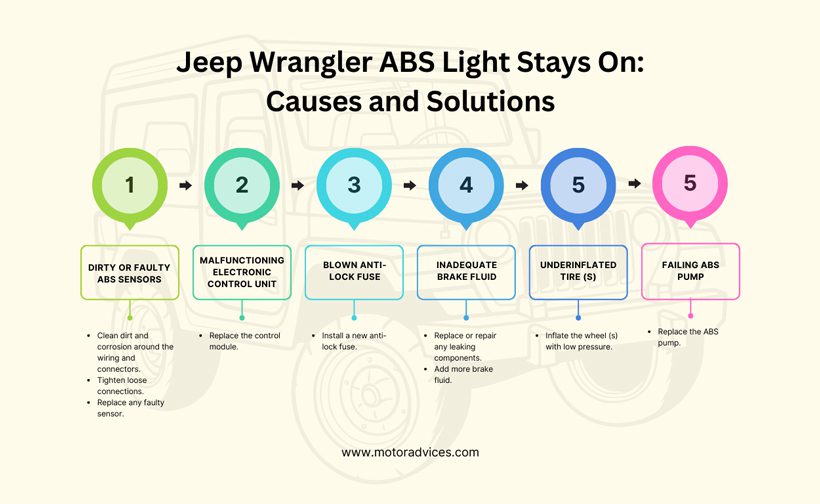Jeep Wrangler ABS Light: Common Causes and Resetting Tips
It is typical for the ABS light to illuminate briefly on the dashboard every time you start your Wrangler. This happens as part of a system check. However, if the ABS lamp stays on while driving, it means there is an issue with the anti-lock braking system.
So, why does the Jeep Wrangler ABS light stay on? Because of any issue with your vehicle’s anti-lock braking system (ABS). And when it occurs, the ABS may not engage when you need to make an emergency stop. As a result, your Jeep could skid. This happens due to
- A dirty or bad ABS sensor
- A failing control module
- Underinflated tires
- Insufficient brake fluid
Want to know more about the causes of the Jeep ABS light coming on and how to reset it? Check out our guide.
Causes of Jeep Wrangler ABS Light Illuminating and Solutions Table

Let’s quickly check out the common causes of the Wrangler ABS light coming on and how to fix the problem.
| Causes | Solutions |
|---|---|
| Dirty or Faulty ABS Sensors | Clean dirt and corrosion around the wiring and connectors. Tighten loose connections. Replace any faulty sensor. |
| Malfunctioning Electronic Control Unit | Replace the control module. |
| Blown Anti-Lock Fuse | Install a new anti-lock fuse. |
| Inadequate Brake Fluid | Replace or repair any leaking components. Add more brake fluid. |
| Underinflated Tire (s) | Inflate the wheel (s) with low pressure. |
| Failing ABS Pump | Replace the ABS pump. |
Jeep Wrangler ABS Light Stays On: Causes and Solutions
If the ECU detects a fault somewhere in the ABS, the Jeep ABS light usually turns on automatically. Below are some common causes of this issue.

1. Dirty or Faulty ABS Sensor(s)
The Wrangler features ABS or speed sensors on all the wheels. These sensors detect the wheels’ speed and relay the information to the ABS control module via an electric signal. When one of the sensors is faulty, it will not send any data to the ABS control unit, causing the ABS light to illuminate.

How To Fix
The first thing you do is inspect the wiring and connectors of the faulty ABS sensor for signs of damage, dirt, or corrosion. Use a clean cloth to wipe away the dirt if it is dirty or corroded. For damaged wiring, you simply replace the broken section and tighten any loose connection.
However, if the speed sensor is damaged, you must replace it, and here is how to do it.
- Step 1: Loosen the tire’s lug nuts with the faulty sensor. Then, jack up your Jeep and remove the lug nuts. Next, take out the tire.
- Step 2: Disassemble the brake assembly that holds the brake pads to access the ABS sensor.
- Step 3: Use a nail and wrench to remove the speed sensor and install the new one.
- Step 4: Reinstall the brake assembly and tire. Then, torque the wheels and test drive your Jeep.
2. Malfunctioning ABS Electronic Control Unit
The ABS electronic control unit or module is a computer that receives data from the speed sensors. After receiving the information, it uses it to prevent your Jeep Wrangler from skidding during sudden braking.
However, moisture, vibrations, and corrosion may damage the control module over time, causing it to fail. Hence, the ABS light will turn on.

How To Fix
Replacing the failing ABS control unit is the best solution, but this is a challenging job. Because after the replacement, the electronic control module (ECM) must be reprogrammed to accept the new module.
In addition, the brakes have to be bled. And in some cases, you have to replace the ABS pump too. As such, you should let the dealer do the job for you.
3. Blown Anti-Lock Fuse
Another component of the ABS is the fuse. The fuse allows electric power to flow to the ABS once you start your car. This helps activate the ABS.
So, when the fuse blows, the antilock brake system stops working, causing the ABS lamp to illuminate on your Jeep’s dashboard. Typically, the fuse may blow due to worn-out wiring, exposed wires, or conductors.
How To Fix
The only solution to a blown anti-lock fuse is to replace it. Here is how to do it:
- Step 1: Disconnect the negative battery cable and locate the main fuse box under your Jeep’s front hood.
- Step 2: Pop up the fuse box and go through the fuse diagram to locate the ABS fuse.
- Step 3: Pull out the anti-lock fuse and test it using a test light or multimeter if it is blown.
- Step 4: If the fuse is blown, the tester will not light up. Similarly, the fuse is faulty if the multimeter reads “OL” or you don’t get a reading.
- Step 5: Install the new fuse and reconnect the negative battery cable.
4. Inadequate Brake Fluid
The Wrangler anti-lock brake system works using electricity and hydraulic pressure. Typically, the hydraulic pressure is created by the brake fluid. Therefore, when brake fluid levels become low due to leakage or worn brake pads, the ABS stops working. This causes the warning light to come on.

How To Fix
Before topping up the fluid levels, check for any leakage and fix the problem. Simply inspect the wheel cylinders, master cylinder, and rubber hoses at each front tire and another above the rear axle.
During the inspection, look for road grime baked around the components. Once you have identified where the leak is coming from, replace or repair the leaking part.
Next, find the brake fluid reservoir in the engine compartment on the driver’s side. Open the reservoir cap and add more fluid to the correct levels. The fluid should not exceed the MAX line. Then, put the cap back on.
5. Underinflated Tire(s)
When one or two tires of your Wrangler have low pressure, they will rotate at different speeds from those with optimal pressure. This information can be detected by the ABS control module via the wheel speed sensors, causing the ABS light to illuminate.

How To Fix
Simply inflate all the wheels to the correct pressure (psi), which is usually between 36 and 38 psi. However, we recommend consulting your vehicle’s manual for the correct tire pressure because it varies depending on your Wrangler’s trim level. Then, drive your Jeep for 10 to 15 minutes above 15 mph to reset the system.
6. Failing ABS Pump
Besides the control module, the ABS is also made up of a hydraulic pump, also known as an ABS motor or modulator. The function of the pump is to restore pressure to the hydraulic brakes once the valves have released it.
Over time, the pump can get damaged or worn due to metal shavings or dirt in the brake fluid, and the warning lamp will illuminate.
How To Fix
Similar to the ABS control module, replacing the ABS pump is a complex procedure for many Jeep owners. Therefore, you should let a skilled mechanic do the replacement.
Faulty Jeep Wrangler ABS Light and Error Codes

Generally, you can diagnose your Jeep ABS light via visual inspection and using a scan tool or OBD-II scanner. An OBD-II scanner tool will help you read any error codes related to the faulty ABS. Some of the codes you will get include:
- C2200 for faulty ABS control module
- C1020, C102A, U140B, and C1027 for faulty left rear speed sensor
- U140A for faulty right front wheel speed sensor
- C1035 for bad right rear speed sensor
- C100A for bad left front speed sensor
How To Reset Jeep Wrangler ABS Light

There are two ways to reset the ABS light in your Jeep. These include:
Using an OBD-II scanner
- To do the resetting, turn the ignition on and plug the scanner into the diagnostic port of your Jeep. You can find the port on the instrument panel between the steering wheel and the door where your legs extend to the brake pedals.
- Next, delete all the error codes related to the ABS using the scanner.
Battery Method
Another way to reset the ABS light on your Wrangler is to unhook the battery. Here is how to do it:
Step 1: Disconnect the negative battery cable and then the positive terminal.
Step 2: Press the horn button several times.
Step 3: Turn on the headlights to drain any electric power in the ABS. Alternatively, you can hold down the brake pedal to drain the electricity.
Step 4: Wait approximately 15 minutes and reconnect the battery, starting with the positive terminal.
If you’re a Jeep Wrangler owner facing an ABS light issue, our article on Honda Civic ABS light on concerns might provide insights that could be relevant to your situation. Additionally, if you’re a Honda CR-V owner dealing with an ABS warning light, our guide on Honda CR-V ABS warning light on matters is here to offer assistance. We recognize the importance of addressing ABS-related issues promptly and maintaining the safety and functionality of your vehicle, and our comprehensive resources are designed to help you navigate and resolve any concerns you may encounter.FAQs
In this section, we will respond to commonly asked queries regarding ABS light on Jeep Wrangler.
Yes. You can drive your Jeep with the ABS light on since the fault does not affect the vehicle’s usual braking. However, you should not let the light stay on longer without having your Jeep checked and the problem fixed.
Yes, but not directly. Generally, worn brake pads cause more brake fluid to be stored inside the calipers. Consequently, this can lead to inadequate brake fluid in the reservoir, triggering the ABS light to illuminate.
Yes, but under normal conditions. However, if there is an issue with the ABS, the light will only go away after fixing the root cause of the problem. Even so, sometimes, you may need to reset the system for the light to go away.
Bottom Line
While it is normal for the Jeep Wrangler ABS light to illuminate briefly, it may not go away sometimes. This happens due to faulty ABS sensors, a failing control module, or a pump.
The good news is that diagnosing the problem is painless via a diagnostic device or visual inspection. And once you have made the diagnosis, you can replace the damaged components or have a certified technician do the repair job. You can quickly reset the system manually or use an OBD-II scanner tool.

